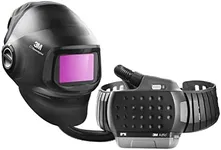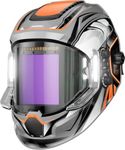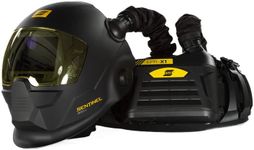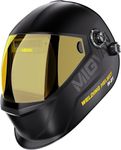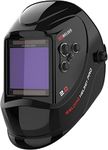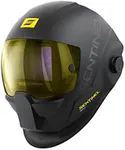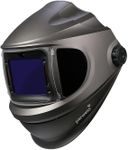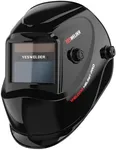Buying Guide for the Best Welding Helmets
Choosing the right welding helmet is crucial for ensuring safety and comfort while working. A good welding helmet protects your eyes and face from harmful radiation, sparks, and spatter. When selecting a welding helmet, consider the type of welding you will be doing, the duration of your work, and your personal comfort preferences. Here are some key specifications to help you make an informed decision.Auto-Darkening Filter (ADF)The Auto-Darkening Filter (ADF) is a feature that automatically adjusts the lens shade based on the brightness of the welding arc. This is important because it allows you to see clearly when not welding and provides protection when you start welding. ADF helmets are generally more convenient and safer as they eliminate the need to flip the helmet up and down. For occasional or hobbyist welders, a basic ADF with fewer shade options may suffice. For professional or frequent welders, a helmet with a wide range of shade settings and faster switching speeds is recommended.
Lens ShadeLens shade refers to the darkness level of the helmet's lens. This is important because it protects your eyes from the intense light produced during welding. Lens shades are typically rated from 5 to 13, with higher numbers indicating darker shades. For light-duty welding tasks, a lower shade (5-8) may be adequate. For more intense welding processes like MIG or TIG welding, a higher shade (9-13) is necessary. Choose a helmet with adjustable shade settings if you plan to work with different welding processes.
Viewing AreaThe viewing area is the size of the lens through which you see while welding. A larger viewing area provides better visibility and can reduce neck strain as you won't need to move your head as much to see your work. This is particularly important for complex or detailed welding tasks. For general welding tasks, a standard viewing area may be sufficient. However, if you work on intricate projects or need a broader field of vision, opt for a helmet with a larger viewing area.
Sensitivity and Delay ControlsSensitivity controls allow you to adjust how easily the helmet reacts to the welding arc, while delay controls determine how long the lens stays dark after the arc stops. These features are important for customizing the helmet's performance to match your specific welding environment and preferences. For example, if you work in a brightly lit area, higher sensitivity may be needed. If you frequently switch between welding and grinding, a shorter delay time can be beneficial. Choose a helmet with adjustable sensitivity and delay settings to tailor it to your needs.
Comfort and FitComfort and fit are crucial for long welding sessions. A well-fitting helmet reduces fatigue and allows you to focus on your work. Look for helmets with adjustable headgear, padded interiors, and lightweight materials. If you wear the helmet for extended periods, prioritize comfort features such as cushioned headbands and balanced weight distribution. Trying on different helmets to find the best fit can make a significant difference in your overall welding experience.
Power SourceWelding helmets can be powered by batteries, solar cells, or a combination of both. This is important because it affects the helmet's reliability and maintenance. Battery-powered helmets offer consistent performance but require regular battery changes. Solar-powered helmets are more environmentally friendly and have lower maintenance needs but may not perform as well in low-light conditions. Combination-powered helmets provide the benefits of both. Choose a power source based on your work environment and preference for maintenance.
Grind ModeGrind mode is a feature that allows you to use the helmet for grinding tasks without the lens darkening. This is important for versatility and convenience, as it eliminates the need to switch between a welding helmet and a grinding shield. If you frequently switch between welding and grinding, a helmet with grind mode can save time and increase efficiency. For occasional grinding tasks, this feature may not be as critical.
